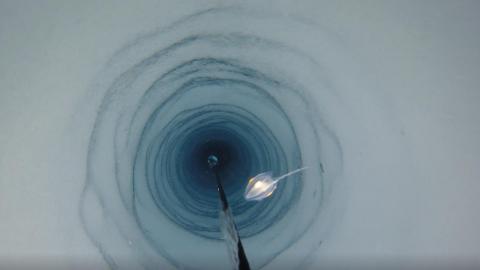Unusual creatures uncovered beneath an Antarctic ice shelf

Credit: Huw Griffiths/British Antarctic Survey
Life finds a way. That way may be uncomfortable, brimming with struggle, and demand an unsightly appendage or two, but as Jeff Goldblum reminds us, “Life will not be contained, life breaks free, it expands to new territories, and it crashes through barriers painfully, maybe even dangerously, but, uh, there it is.”
To crash through those barriers, however, creatures must find the requirements for life waiting on the other side: namely, liquid water, a source of energy, and biogenic elements such as carbon and nitrogen. While terrestrial life has found some environments too hostile to call home, it’s also evolved mind-boggling adaptations that allow it to access those three essentials in some bizarre places.
For example, the denizens of hydrothermal vents—such as the yeti crabs, scaly-foot gastropods, and Pompeii worms—dwell too deep in the ocean for sunlight to reach. Because their food chains can’t rely on photosynthesis, they’re supported by microbes that utilize a process called chemosynthesis, which converts chemicals from the vents into sugars and, in turn, useable energy.
Similarly, the Atacama Desert is a place so dry and barren that scientists compared it to the rusty dunes of Mars. Yet, even here, life has found a way in the form of microbes who wait patiently for those fleeting spits of rainfall to replicate.
And a new study, published in Frontiers in Marine Science, has proven Goldblum correct, uh, yes, once again. The study details the discovery of unusual creatures in one of the most unsympathetic environments on Earth’s most inhospitable continent.

The Antarctic sessile creatures photographed on their home boulder.Credit: Frontiers in Marine Science
Researchers made the discovery while drilling boreholes on the Filchner-Ronne Ice Shelf. Antarctica’s ice shelves are giant, permanent floating ice sheets connected to the continent’s coastlines, with the Filchner-Ronne shelf being one of the largest. Using a hot-water drill system, they bore through roughly 900 meters of the ice looking for sediment samples. Instead, they discovered a boulder. Two hundred sixty kilometers away from the ice front, the rock was nestled in a world of complete darkness at -2.2°C. And on it, they found sessile organisms.
“This discovery is one of those fortunate accidents that pushes ideas in a different direction and shows us that Antarctic marine life is incredibly special and amazingly adapted to a frozen world,” Dr Huw Griffiths, the study’s lead author and a biogeographer of the British Antarctic Survey, said in a press release.
Sessile creatures are defined by their inability to move freely. They live their lives anchored to a substrate—in this case, the aforementioned boulder. Common sessile animals found in coastal tide pools include mussels, barnacles, and sea anemones, yet none of these were present beneath the Antarctic shelf. Instead, the researchers discovered a stalked sponge, roughly a dozen non-stalked sponges, and 22 unidentifiable stalked organisms.
Previous boreholes had revealed creatures living in these murky waters, but they had always been free-moving predators and scavengers such as jellyfish and krill. It’s not too surprising to find such animals under the ice shelves as their mobility allows them to seek out food that may drift beneath.
But sessile organisms depend on their food to be delivered to them. That’s why they are so bountiful in tide pools; tides and currents are the DoorDash of the ocean world. It’s also why the researchers found the sponge’s Antarctic lodgings so astounding. Because they live 1,500 kilometers upstream from the nearest source of photosynthesis, it’s unknown how a food supply reaches these sponges or whether they generate nutrients from some other means, such as glacial melt or carnivorous noshing.
“Our discovery raises so many more questions than it answers, such as how did they get there? What are they eating? How long have they been there? How common are these boulders covered in life? Are these the same species as we see outside the ice shelf or are they new species? And what would happen to these communities if the ice shelf collapsed?” Griffiths added.
To answer those questions, researchers will need to revisit the sponges to collect samples and study them in more depth. We’ll also need to explore further the vast reaches of the Antarctic continental shelf. According to the release, counting the previous boreholes, scientists have only studied an area roughly the size of a tennis court to date.
When will we find alien life? Place your bets! | Michelle Thaller | Big Thinkwww.youtube.com
As science discovers life in more and more unusual places, it’s also considering more and more that life has not been contained to our pale blue dot. For example, the recent discovery of microbial life in the Atacama Desert has reignited hope that evidence of past life will be found on Mars. NASA’s Perseverance Rover recently land on Mars to begin analyzing soil samples from the Jezero Crater to test that hypothesis.
Looking to the future, NASA’s Dragonfly rotorcraft aims to explore the Saturn moon of Titan. The icy moon has a makeup similar to early Earth’s, so the vehicle will study the moon’s atmosphere and surface for signs of chemical evidence for life. And the ice-covered surface of Europa could hold twice as much water as Earth and a bevy of hydrothermal activity that could harbor life within our solar system.
Here life is, uh, and there it may be.





